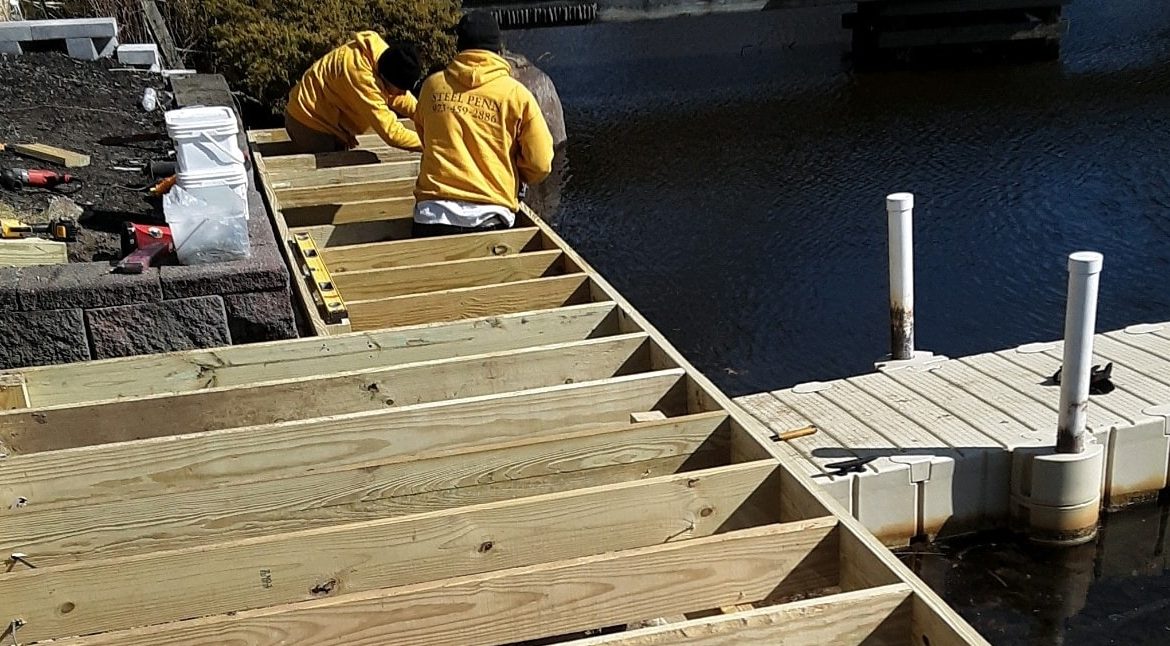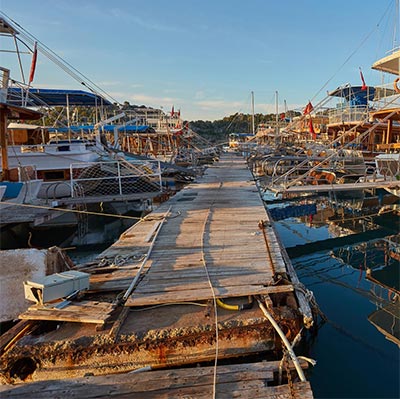Specialist Insights on Durable Dock Repairs Solutions
Specialist Insights on Durable Dock Repairs Solutions
Blog Article
Reliable Dock Repair Techniques: Making Certain Architectural Honesty
Guaranteeing the architectural integrity of docks via efficient repair techniques is vital for the durability and security of marine facilities. Consequently, choosing the ideal fixing products, such as corrosion-resistant alloys and composite products, is crucial for resilience.
Evaluating Dock Damage
Evaluating dock damages is a vital very first step in guaranteeing the structural integrity and safety of any kind of docking center. This first analysis includes a detailed evaluation to identify both noticeable and concealed damages. Secret elements to examine include the dock's foundation, pilings, decking, and equipment. Each element should be scrutinized for indicators of wear, rot, rust, or other kinds of destruction that could endanger the architectural integrity.
Structural designers or qualified examiners usually perform these evaluations making use of specialized tools and strategies. Undersea inspections might utilize finder equipment or remotely ran lorries (ROVs) to spot immersed damages. Over water, visual assessments are matched by utilizing moisture meters and other analysis devices to reveal underlying issues not right away noticeable to the nude eye.

Deciding On Fixing Materials
Choosing the proper repair materials is an essential action in the dock restoration process, one that directly influences the durability and performance of the fixed framework. Product option must be driven by elements such as environmental problems, load-bearing needs, and compatibility with existing dock parts. Timber is a traditional choice for docks due to its natural resilience and aesthetic appeal. However, selecting the best kind of wood, such as pressure-treated lumber or naturally rot-resistant species like cedar or teak wood, is critical to withstand aquatic settings.
Along with wood, composite materials are significantly prominent due to their longevity and reduced maintenance demands. Composites, commonly made from a blend of plastic and timber fibers, provide excellent resistance to rot, bugs, and UV damage. For steel anchors, selecting corrosion-resistant alloys such as galvanized steel or marine-grade aluminum is important to protect against rust and ensure architectural integrity in saline water problems.
Epoxy materials and marine-grade sealers are important for fixing fractures and securing joints, giving a water-proof obstacle and boosting the dock's overall stamina. By diligently selecting top notch products, dock fixings can attain durable outcomes, therefore guarding against future degradation and guaranteeing risk-free, trusted usage.
Architectural Support Methods
Efficient structural reinforcement methods are vital in guaranteeing the stability and longevity of dock fixings. One basic technique involves the use of steel or composite reinforcement bars (rebar) within concrete structures. Rebar gives added tensile stamina, preventing splits and dispersing tons more equally. This method is specifically efficient for docks revealed to heavy loads or rough environmental conditions.
One more essential strategy is the application of fiber-reinforced polymers (FRP) These materials provide high strength-to-weight proportions and exceptional resistance to rust, making them suitable for strengthening concrete or wood docks. FRP can be used in strips or sheets and bonded with epoxy resins to enhance architectural integrity.
Supporting and securing systems also play an essential function in architectural reinforcement. Cross-bracing, utilizing steel or wood beam of lights, can neutralize lateral forces, lowering swaying and motion. Securing systems, such as helical piers or driven heaps, provide a steady structure by moving loads to much deeper, extra stable soil layers.
Finally, the assimilation of load-distribution plates read this post here can aid distribute weight much more uniformly throughout the dock's surface area, mitigating localized anxiety factors. These strategies jointly ensure that docks continue to be durable and secure, qualified of holding up against the roughness of their functional atmosphere.
Advanced Repair Work Techniques
One more sophisticated strategy involves underwater welding, which permits repairs to be carried out without the demand to dewater the location. This method is especially helpful for addressing structural issues in submerged dock elements, making sure marginal disruption to operations. Enhanced welding techniques, combined with robotic systems, provide precision and dependability, consequently expanding the lifespan of the dock.
Additionally, cathodic protection systems are executed to avoid deterioration in metal dock frameworks. By utilizing sacrificial anodes or pleased present systems, these methods properly minimize the electrochemical procedures that bring about product damage.
Last but not least, progressed tracking innovations, such as structural health surveillance (SHM) systems, give real-time information on the problem of dock structures. These systems enable proactive upkeep and prompt interventions, ultimately making certain the lasting structural integrity of the dock.
Upkeep and Avoidance
Maintenance and avoidance are basic ideas that underpin the longevity and safety and security of dock frameworks. Regular examinations are extremely important, enabling early discovery of deterioration, potential weak points, and environmental influences. A positive approach, entailing routine look for rust, rot, and structural changes, reduces pricey repair services and prolongs the dock's functional life.
Preventive actions ought to include using safety layers to metal parts to defend against rust and utilizing cured wood to stand up to decay. Furthermore, ensuring correct drainage and ventilation can protect against water build-up, which is an usual cause of architectural degradation. Including quality products and sticking to maker guidelines look at this site during building and repair phases additionally play crucial functions in boosting sturdiness.

Training personnel in dock upkeep best techniques makes sure consistent application of preventative steps. Leveraging technical developments, such as drones for inspections and sensing units for real-time monitoring, can better boost upkeep initiatives. By prioritizing upkeep and avoidance, dock owners can make certain structural stability, functional security, and cost-effective administration over the dock's life-span.
Final Thought
To conclude, maintaining the architectural honesty of marine facilities requires thorough dock repair methods. Detailed inspections utilizing sophisticated devices uncover both visible and concealed problems, while the selection of ideal repair service materials improves resilience. Applying structural support techniques addresses stress factors efficiently. Advanced repair service strategies, coupled with routine maintenance methods, ensure the dock remains functional and risk-free under varied ecological problems. Taking on these approaches significantly extends the life-span and capability of aquatic facilities.
Making sure the structural stability of docks via reliable repair service techniques is paramount for the long life and security of marine centers.Selecting the ideal repair service materials is a pivotal action in the dock remediation procedure, one that directly affects the durability and performance of the fixed structure.Reliable structural support techniques are essential in making sure the stability and long life of dock repair services. By prioritizing maintenance and avoidance, dock owners can make sure structural stability, functional safety, and cost-efficient management over the dock's life-span.
In conclusion, keeping the architectural integrity of marine centers necessitates detailed dock repair methods.
Report this page